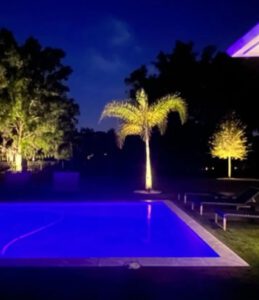Landscape Lighting Orlando extends living space in ways that are both physical and visual. It can highlight unique features of your property and make it easier to navigate the outdoors after dark. However, it would help if you kept a few things in mind before installing landscape lighting. Begin with a rough sketch of your property, breaking it into regions (zones). Then, determine what you want to light up and where each fixture will be located.
Lightning is a natural phenomenon that has fascinated and terrified humans for centuries. It occurs when electricity from different clouds discharges through the atmosphere and Earth’s surface. It is an important part of the Earth’s weather system and responsible for many of its most powerful storms. It is a complex process that has yet to be fully understood. It is also one of the most destructive forces on Earth. Lightning strikes can cause serious injuries and damage buildings and other structures. It can also burn forests, kill livestock and pets, and destroy crops.
Lightning happens when excess positive and negative charge regions develop within a thunderstorm cloud. These charges reside on water droplets and ice crystals in the clouds, and they separate due to vigorous rubbing. Eventually, the lighter positive charge migrates toward the upper edge of the cloud, while the heavier negative charge migrates to the lower edge. The positive and negative charges then connect at the Earth’s surface through a series of steps that form plasma channels. These channels travel downward until they reach the ground, where they release their charge in a visible flash of lightning. There are several types of lightning, including sheet lightning, forked lightning, and ribbon lightning. These phenomena occur in various situations, such as volcanic eruptions, extreme forest fires (pyrocumulonimbus clouds), and snowstorms. They can also be seen in tornadoes, large hurricanes, and thunderstorms.
Most lightning discharges happen between a cloud and the ground. They may also be seen between two clouds or inside a single cloud. However, these forms of lightning are not considered true lightning. True lightning is the rapid discharge of electrons from the cloud to the ground or other objects. It is often accompanied by thunder, which emerges as gases in the lightning discharge experience a sudden increase in pressure.
Lightning is most frequent in summer when there are high levels of instability and moisture in the air. Without these conditions, strong convective thunderstorms would not be able to form. In the winter, insufficient instability or moisture allows convective storms to develop.
It is easy to get caught up in the beauty of landscape lighting and forget that it can also be a danger. Several people are injured or killed each year by lightning strikes. While these numbers are low, they are reminders that it can happen and that we should take the risk seriously.
Avoiding open fields, hills, and lone trees during thunderstorms is important. They attract lightning and are the most likely to be hit. When a tree is struck, it can explode, fall over, or catch fire. It may also drop branches or limbs, which can cause injuries to people in the vicinity.
In addition, people should avoid tall structures, such as buildings, fences, and telegraph poles. They should also stay away from water bodies and hilltops. When the storm comes, they should seek shelter immediately. The best place to go is a building with a roof, which protects from lightning. They should not lie flat on the ground as this increases their chance of being affected by a ground current.
Landscaping lighting can also be dangerous if it is not grounded properly. The lightning may discharge through the wires, causing them to fall short and become hot. If this happens, it is important to have the system professionally repaired or replaced. Using only landscape lights with grounded metal connections is also important.
People should check the NOAA weather reports during a storm before going outdoors. They should also look for signs of a developing thunderstorm, such as darkening clouds or a build-up of wind speed. They should also avoid areas with standing water, as they are at greater risk of being struck by lightning.
Many commercial and residential landscapers work outside during the summer. It is tempting to stay outside long after the weather has turned bad to complete a project. However, it is important to take the risk of lightning seriously and stay inside when a storm is approaching. Suppose you are caught working outdoors during a thunderstorm. In that case, you should always wear rubber-soled shoes and avoid leaning on anything that could conduct electricity, such as metal ladders or fences.
As a professional landscape lighting installer, receiving a call from a client who says their lights aren’t working is one of the worst nightmares. It can mean hours of sleuthing to try and figure out what caused the problem, especially if it is a lighting short.
The most common landscape lighting problems are due to a wire or bulb connection problem. The wires are usually buried under mulch or in the ground and can be subject to moisture, leading to corrosion. This can cause the wires to become disconnected from the transformer. Alternatively, the wattage of all the lights added together can exceed the transformer’s capacity, leading to its tripping.
Another common problem is the timer or photocell needing to be fixed. This can be due to several reasons, such as power loss or the timer being set incorrectly. Even photocell-controlled systems with a battery backup can lose their charge, causing the light to not come on at the right time.
You can do several things to troubleshoot your landscape lighting system, including turning off the power and unplugging all of the fixtures. Once you’ve done that, ensure the transformer is plugged in and has power. You can use a digital voltage meter to check each fixture’s socket and ensure it gets the proper amount of current. If the socket is not getting enough current, it will burn out the bulb quickly. You can also use an emery board or sandpaper to remove any corrosion from the bulb fixture’s contacts, then spray it with contact cleaner before replacing it.
The landscape concept extends beyond the physical environment and is how people perceive their surroundings. This may take the form of traditions and lore but can also include how individuals or communities make sense of their environments through their beliefs, associations, and relationships. This is often referred to as the cultural landscape.
Landscapes have long been of interest to cultural geographers and archaeologists. The inter-war period saw the journal Antiquity introduce the notion of ‘landscape archaeology,’ encouraging archaeological sites and remains to be considered part of structured, evolving landscapes.
In the mid-1990s, two edited collections (Feld & Basso, 1996; Hirsch & O’Hanlon, 1995) and a reader (Low & Lawrence-Zuniga, 2003) marked a self-conscious effort to develop a distinctively anthropological approach to landscape, with the central aim being to unpack Western concepts of landscape and place in order to make theoretically visible the spatial dimensions of culture.
Some anthropologists, like Carl Troll, consider landscape an objectively given ‘organic entity’ or ‘harmonic individuum’ of space. Others, such as Claude Lévi-Strauss, consider the ‘landscape’ a process of becoming that can only be experienced through a particular way of seeing.
Whatever landscape definition you adopt, it is important to communicate your project’s vision with your pro. This will help them create a beautiful, functional, and sustainable space for you and your family while staying true to the surrounding ecosystem. In addition, it is important to remember the needs of your yard users – be they your family, pets, or neighbors.

